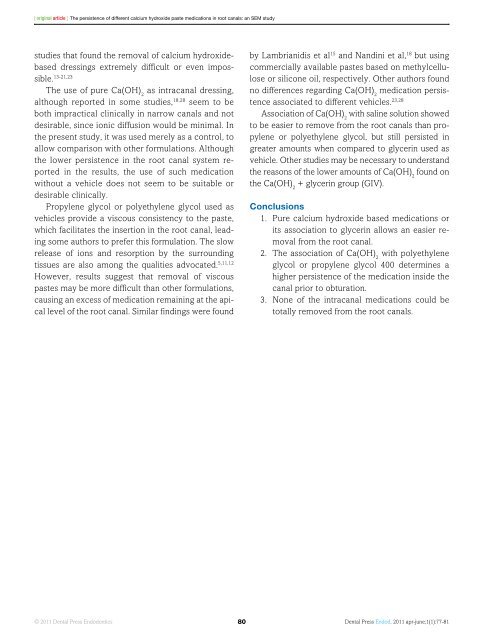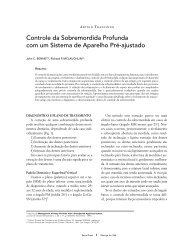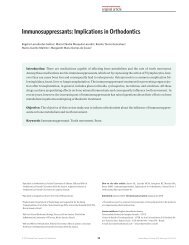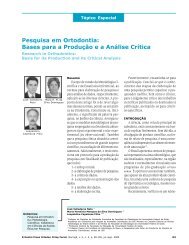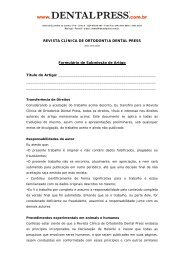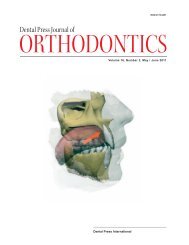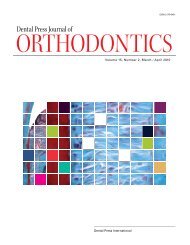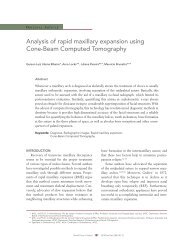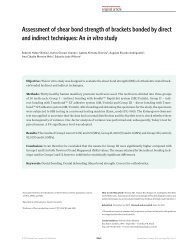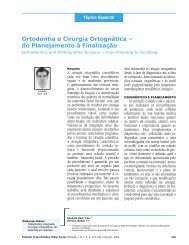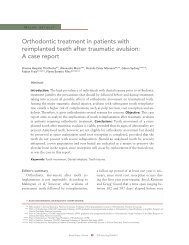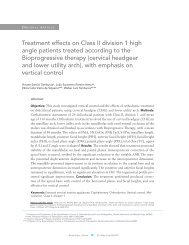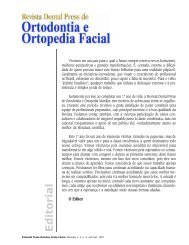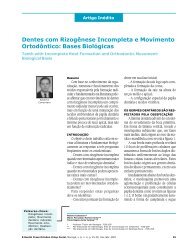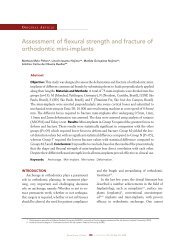Dental Press
Dental Press
Dental Press
Create successful ePaper yourself
Turn your PDF publications into a flip-book with our unique Google optimized e-Paper software.
[ original article ] The persistence of different calcium hydroxide paste medications in root canals: an SEM study<br />
studies that found the removal of calcium hydroxidebased<br />
dressings extremely difficult or even impossible.<br />
13-21,23<br />
The use of pure Ca(OH) 2<br />
as intracanal dressing,<br />
although reported in some studies, 18,28 seem to be<br />
both impractical clinically in narrow canals and not<br />
desirable, since ionic diffusion would be minimal. In<br />
the present study, it was used merely as a control, to<br />
allow comparison with other formulations. Although<br />
the lower persistence in the root canal system reported<br />
in the results, the use of such medication<br />
without a vehicle does not seem to be suitable or<br />
desirable clinically.<br />
Propylene glycol or polyethylene glycol used as<br />
vehicles provide a viscous consistency to the paste,<br />
which facilitates the insertion in the root canal, leading<br />
some authors to prefer this formulation. The slow<br />
release of ions and resorption by the surrounding<br />
tissues are also among the qualities advocated. 5,11,12<br />
However, results suggest that removal of viscous<br />
pastes may be more difficult than other formulations,<br />
causing an excess of medication remaining at the apical<br />
level of the root canal. Similar findings were found<br />
by Lambrianidis et al 15 and Nandini et al, 18 but using<br />
commercially available pastes based on methylcellulose<br />
or silicone oil, respectively. Other authors found<br />
no differences regarding Ca(OH) 2<br />
medication persistence<br />
associated to different vehicles. 23,28<br />
Association of Ca(OH) 2<br />
with saline solution showed<br />
to be easier to remove from the root canals than propylene<br />
or polyethylene glycol, but still persisted in<br />
greater amounts when compared to glycerin used as<br />
vehicle. Other studies may be necessary to understand<br />
the reasons of the lower amounts of Ca(OH) 2<br />
found on<br />
the Ca(OH) 2<br />
+ glycerin group (GIV).<br />
Conclusions<br />
1. Pure calcium hydroxide based medications or<br />
its association to glycerin allows an easier removal<br />
from the root canal.<br />
2. The association of Ca(OH) 2<br />
with polyethylene<br />
glycol or propylene glycol 400 determines a<br />
higher persistence of the medication inside the<br />
canal prior to obturation.<br />
3. None of the intracanal medications could be<br />
totally removed from the root canals.<br />
© 2011 <strong>Dental</strong> <strong>Press</strong> Endodontics 80<br />
<strong>Dental</strong> <strong>Press</strong> Endod. 2011 apr-june;1(1):77-81


